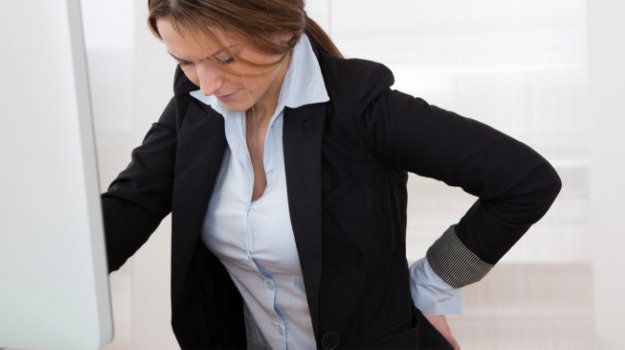7 Best Lower Back Pain Exercises You Can Do at Your Office Desk

Backache is a very common complaint which affects all age range. Pain in the lower part of the back is commonly referred to as Lumbago. It can be defined as mild to severe pain or discomfort in the area of the lower back.The pain can be acute (sudden and severe) or chronic if it has lasted more than three months.
Lower back ache is one of the world’s No. 1 health complaint amongst corporate employees. It is the most common cause of job-related disability. Lower back ache is gender agnostic, ie. it attacks both men and women equally. It can range in intensity from a dull, constant ache to a sudden, sharp sensation that leaves the person incapacitated. Sedentary lifestyles are the main cause of lower back ache. Most lower back ache cases are acute, or short term, and the pain lasts a few days to a few weeks. It tends to resolve on its own with self-care and there is no residual loss of function.
The lower back, or lumbar area provides structural support, movement, and protection of certain body tissues. As most of the employees spend their working hours sitting, lower back is subjected to a lot of stress and strain due to weight of the upper body. Lower back ache is caused due to conditions affecting the bony lumbar spine, discs between the vertebrae, ligaments around the spine and discs, spinal cord and nerves, muscles of the low back, internal organs of the pelvis and abdomen, and the skin covering the lumbar area.

Symptoms
Lower back ache symptoms may include any of the following:
1. Dull aching pain
2. Sharp pain
3. Tingling or burning sensation
4. Weakness in your legs or feet
Lower back ache can differ from person to person. The ache may be mild, or it can be so severe that you cannot move. Depending on the cause of your back ache, you may also have pain in your leg, hip, or the bottom of your foot.
Lower back ache is triggered by everyday activities, injury, overuse and it is aggravated by prolonged rest or inactivity. Long hours of sitting or standing and incessant quick movements can be other triggers.
Remedies
However, lower back ache can be overcome or controlled by regular exercises to strengthen the muscles that support your back — especially the abdominals, hips, back, and pelvic area. These exercises strengthen core muscles and relieve the ache. Here are a few important exercises that help employees soothe their muscles and quell the ache.

Exercises for the Back You Can Do at Your Desk
1. Just stand up and sit down – not using hands
– If you stand up and sit down (over and over) without using your hands – it can be a challenge.
2. Substitute exercise for sitting – while you work
– Get rid of your desk chair and substitute an exercise ball. All day you are engaging all the muscles in the back, specially core muscles, to stay balanced.”
3. Release the whole back with a torso twist
– Inhale and as you exhale, turn to the right and grab the back of your chair with your right hand, and grab the arm of the chair with your left.
– Use your grasp on the chair to help twist your torso around as far to the back of the room as possible. Hold the twist and let your back continue the stretch – see how far around the room you can peer.
– Slowly come back to facing forward.
– Repeat on the other side.
4. Stretch your back with a “big hug”
– Hug your body, placing the right hand on your left shoulder and the left hand on your right shoulder.
– Breathe in and out, releasing the area between your shoulder blades.
5. Stretch your back and shoulders with a “leg hug”
– Sit on the edge of your chair (if it has wheels, wedge the chair against the desk or wall to make sure it does not roll). Put your feet together, flat on the floor.
– Lean over, chest to knees, letting your arms dangle loosely to the floor. Release your neck.
– Now bring your hands behind your legs, right hand grasping left wrist, forearm (or elbow if you can reach that far), left hand grasping the right. Feel the stretch in your back, shoulders and neck. Hold.
– Release your hands to the floor again.
– Repeat three times or as often as it feels good.
6. Look up to release upper body
– Sit up in your chair, or stand up. Stretch your arms overhead and interlock your fingers.
– Turn the palms to the ceiling as you lift your chin up, tilt your head back, and gaze up at the ceiling too.
– Inhale, exhale, release.
7. Substitute walks for email
– Instead of emailing a colleague, just walk over instead. The exercise is effortless and will keep you in shape if habitual.

[“source-ndtv”]


